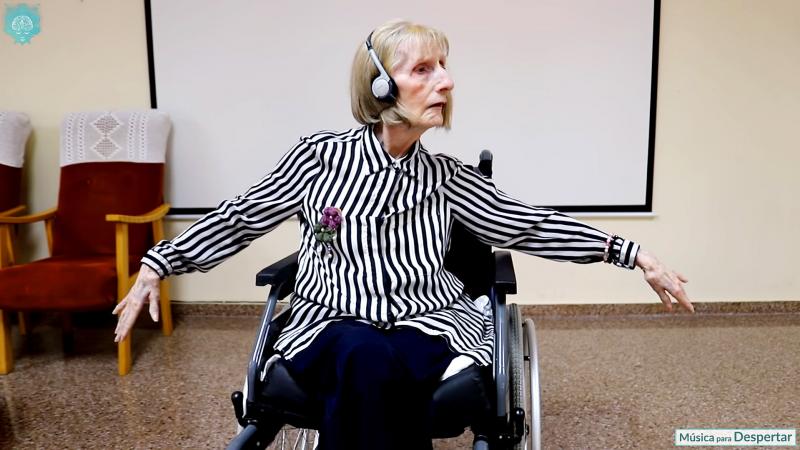We see a frail and elderly woman in a chair, her eyes downcast. She motions for the music to be turned up, a swelling melody from Tchaikovsky’s Swan Lake, and with a little encouragement her hands begin to flutter. Then suddenly her eyes flash and she’s Odette the swan queen at the misty lakeside, arms raised. She leans forward, wrists crossed in classic swan pose; her chin lifts as if she’s commanding the stage once more, her face lost in reverie.
The woman in the film is Marta Cinta Gonzalez Saldana, a former ballet dancer who died last year, the year the video was shot. But the clip has gone viral since being posted recently by Spanish organisation Musica Para Despertar (Music to Awaken), which promotes the value of music for those living with Alzheimer’s.
The particular ability of music to connect with people living with even severe dementia is becoming well known.

Photo courtesy of Musica para Despertar 照片:「喚醒的音樂」提供
Auditory memory may be the last thing to leave us because it’s one of the first things we develop, at around 18 weeks in the womb, says Grace Meadows, program director at Music for Dementia. “They’re some of the deepest neural pathways that get laid down,” she says. Our first language, the babbling and cooing of babies and their carers, is a form of musical exchange. “That’s why it’s so deep and why we’re so responsive to it, because it’s so primal.”
That remains true when people have cognitive impairments, partly because music is processed in so many different parts of the brain. If there’s something blocking its neural pathway, it finds another path. And music from formative stages in our lives tends to have the strongest hold, especially around the teenage years and 20s, the “memory bump” as it is called, when so many intense social bonds and new emotions and experiences take place: first loves, moving to new cities, or perhaps dancing your first leading role on stage.
For Saldana, a strong muscle memory is tied to those musical instincts, but you don’t have to have been a professional dancer for music to spark a physical response.
(The Guardian)
我們看到一位年老體弱的女人坐在椅子上,目光低垂。柴可夫斯基《天鵝湖》的悠揚旋律流瀉出,她示意將音量調高,受到一些鼓勵後,她的手開始顫動。然後她的眼睛忽然閃爍起來,便化身為霧氣迷濛湖畔的天鵝女王奧潔塔,舉起雙臂。她俯身,手腕以經典的天鵝姿勢交叉;她將下巴抬起,彷彿再次縱橫舞台,她的臉龐陷入遐思。
影片中的女人是曾為芭蕾舞者的瑪塔‧辛塔‧貢沙雷斯‧沙爾達尼亞,她已在二○一九年,亦即此影片拍攝的同年去世。但該影片自從最近被西班牙組織「喚醒的音樂」(Musica Para Despertar)發布以來便爆紅。「喚醒的音樂」將音樂的價值推廣給阿茲海默症患者。
音樂具有特殊的能力,可以與人溝通,即便是重度失智的人,這一點已漸為周知。
聽覺記憶可能是最後離開我們的,因為它是最先形成的東西之一,大約在子宮內十八週後發展出來,「給失智者的音樂」計畫總監葛雷絲‧梅多斯說道。「所生成的是一些最深層的神經路徑」,她說。我們的第一語言,即嬰兒的咿呀聲及其照顧者的輕柔低語,是一種音樂交流的形式。「這就是為什麼它如此深刻,也是為什麼我們對它那麼有反應,因為它是如此原始」。
即便有認知障礙,情況仍是如此,部分是由於音樂是在大腦許多不同部位處理的。若其神經路徑受到阻礙,它便找到另一條路徑。我們在成長階段所聽的音樂往往具有最強的影響力,尤其是在大約十幾二十歲時,這就是所謂的「記憶隆起」(memory bump),許多強烈的社交聯繫、新的情感與經驗在那段時期發生:初戀、搬到新城市,或是第一次在舞台上扮演主角。
就沙爾達尼亞而言,她強烈的肌肉記憶(muscle memory)與這些音樂本能是密切連結在一起的,但你不需要是專業的音樂舞蹈家才能讓音樂激發身體反應。
(台北時報林俐凱編譯)

The Australian government will legislate for a ban on social media for children under 16, Prime Minister Anthony Albanese said on Thursday last week, in what it calls a world-leading package of measures that could become law late next year. Australia is trialing an age-verification system to assist in blocking children from accessing social media platforms, as part of a range of measures that include some of the toughest controls imposed by any country to date. Albanese cited the risks to physical and mental health of children from excessive social media use, in particular the risks to girls from harmful depictions of

A: I’m going to Blackpink member Lisa’s fan meeting at the K-Arena on Sunday. B: Wow, this will be her first visit to Taiwan after going solo. A: Yeah, Lisa’s so popular that she’s now the most-followed K-pop singer on Instagram. B: Meanwhile, other members Jennie’s and Rose’s new songs are also well-liked. A: I hope they can reunite with Jisoo as a group again soon. A: 我週日要去女團Blackpink成員Lisa的高雄巨蛋見面會。 B: 哇,這可是她單飛後首次來台。 A: 對啊,她的人氣持續高漲,是IG上粉絲最多的南韓歌手。 B: Jennie和Rose最近推出的新歌也都大受歡迎。 A: 希望她們和Jisoo趕快合體開唱吧! (By Eddy Chang, Taipei Times/台北時報張聖恩)

Can you recall the stuffed animal that played with you in happy times and comforted your sorrows during your childhood? These soft companions often became our first friends. Yet, as we grew up, many were left behind. This inspired Charlotte Liebling to found Loved Before and give these cherished toys a new opportunity to spread joy. The story begins while Liebling was volunteering at a charity secondhand store in London. There, she discovered numerous boxes filled with donated stuffed animals. As a lover of stuffed toys, she could see their emotional value, but she was also distressed by a

A: Apart from Blackpink member Lisa, who else is set to visit Taiwan? B: Supergroup Take That will perform in Kaohsiung on Nov. 16, followed by singer Dua Lipa in Taoyuan on Nov. 20. A: Oh my gosh, Take That was my favorite group when I was young. B: Plus, South Korean singer BoA is also coming to Taipei on Nov. 23. A: As a first-generation K-pop diva, BoA’s show will definitely be awesome. A: 除了Blackpink 成員Lisa,還有哪些藝人會來台? B: 天團接招合唱團11月16日在高雄開唱,歌手杜娃黎波20日在桃園開唱。 A: 天啊,接招是我年輕時最愛的樂團! B: 南韓歌手寶兒,23日也將在台北開唱。 A: 她可是第一代韓流天后,一定超精彩。 (By Eddy Chang, Taipei Times/台北時報張聖恩)